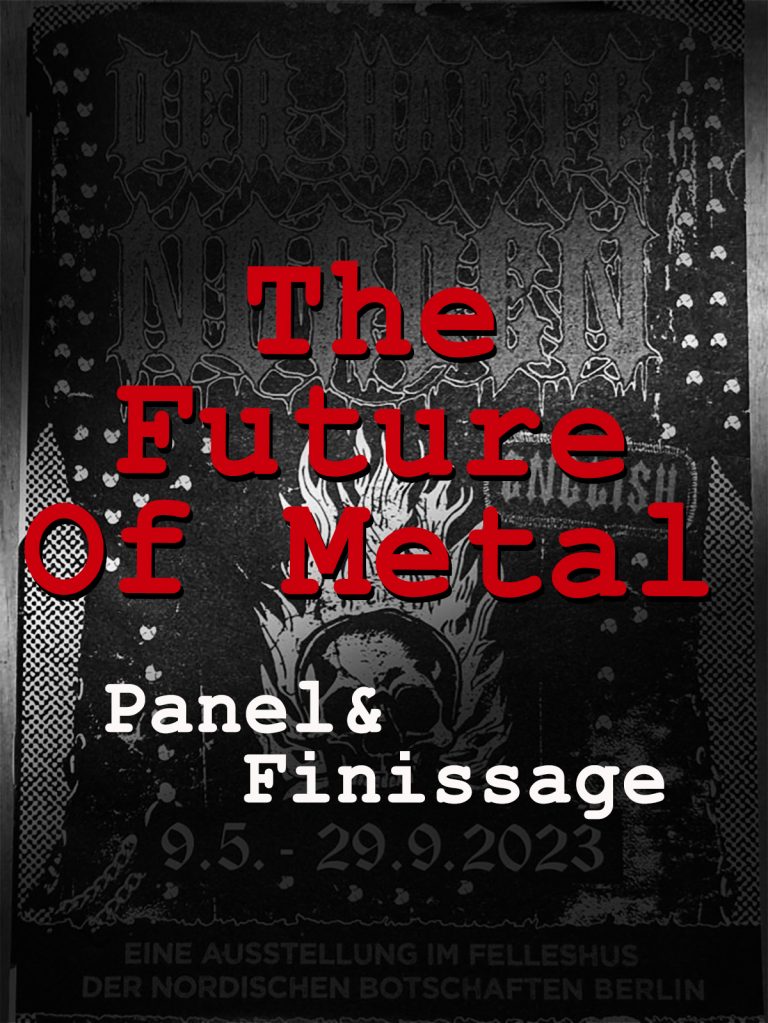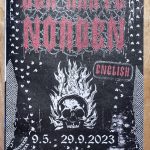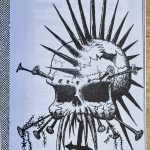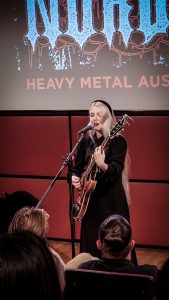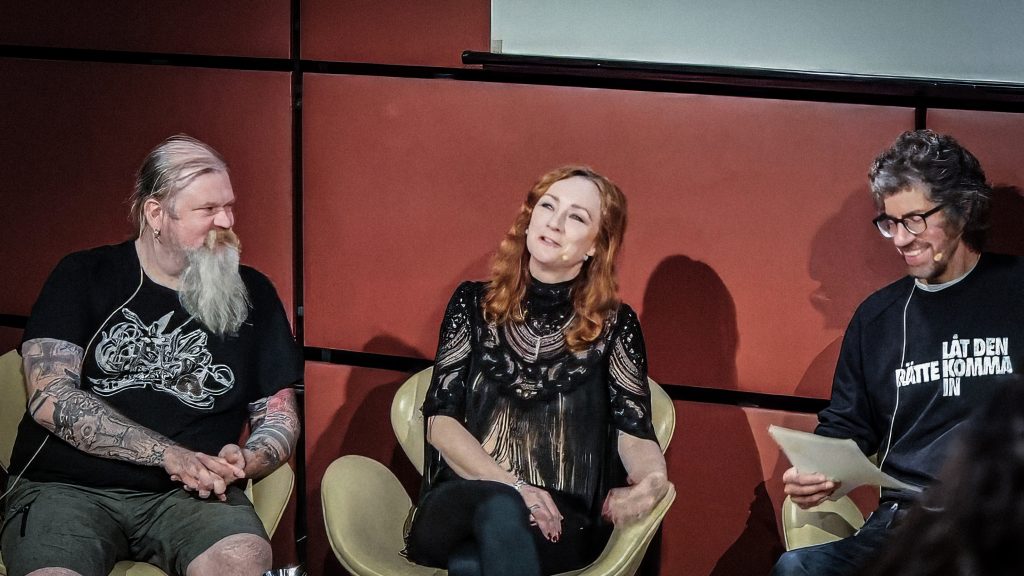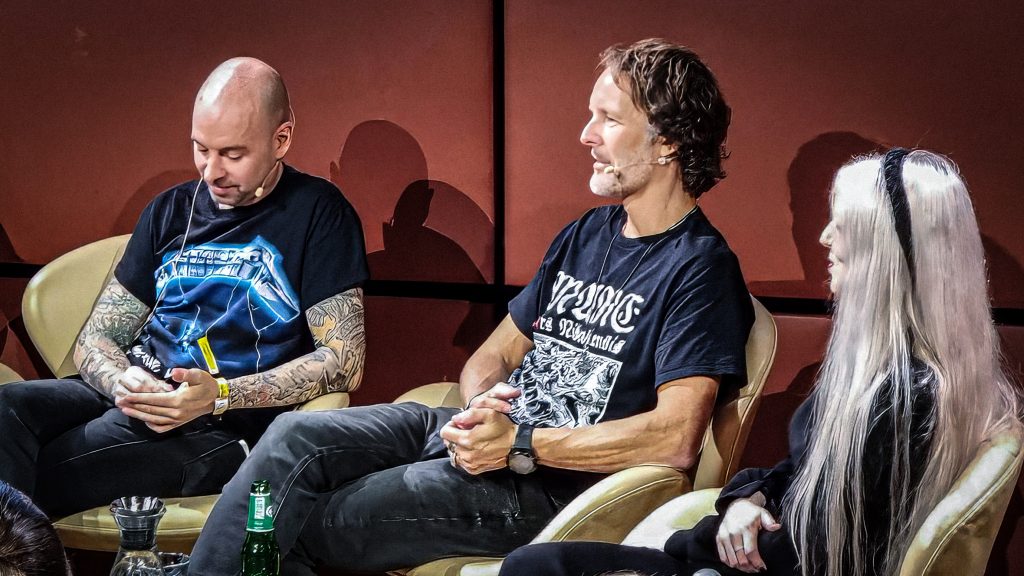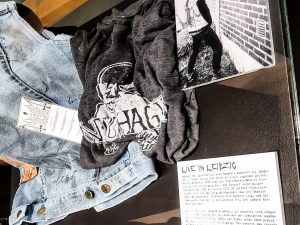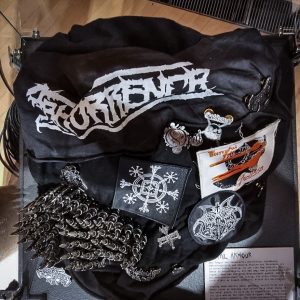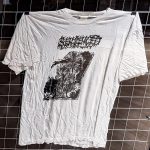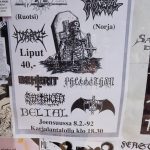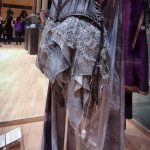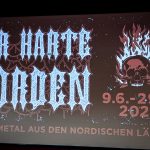Berlin, 29th September, 2023. In the warm evening sun, some 200 metalheads queue up in front of Fellehus, a building run by the Nordic embassies in Berlin. They wait to attend the finissage of the exhibition “Der harte Norden”. A panel discussion about the future of metal music and a semi acoustic, solo concert by Sylvaine. It displays a vast collection of devotional objects illustrating mainly the past three decades of metal music in Iceland, Norwegian, Denmark, Sweden and Finland.
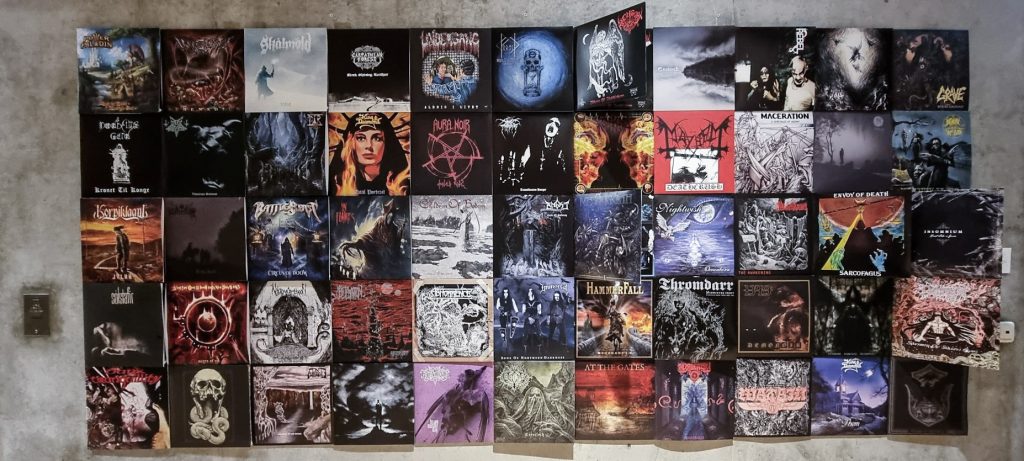
A Metal Exhitbition in the Nordic Embassy Facilities
Even in Berlin and even in 2023 an exhibition of the history of metal hosted by an embassy is still special. Metal as music genre is still mostly considered underground, the lovers of the music taken a subculture. The majority of concerts take place in small clubs. The metal festival’s audiences characteristically is a community of people with only few fluctuation. The extreme soundscapes still provoke and scare away rather than attract. And yet some have made it to million sellers, national music award winners, on opera stages and become a part of national heritage. This perhaps is where metal from Nordic countries differs from that of other parts of the world. No one would have expected that when in the 1990s teenagers competed in making their guitars sound as dirty and raw as technically possible. Even less when violence erupted in burning churches or homicide. However, 30 years later thousands of people walk through Fellehus admiring distorters, denim jackets, a coffin and whatnot. “Der harte Norden” was a story of great and partially unexpected success.
The Finissage
No event taking place in such an environment goes without official notice. As such, Berlin Kultursenator Joe Chialo sends his regards in a video message, revealing his own love for metal music. He puts an emphasis on the importance of metal subculture for Berlin as virtual host of events, for example.
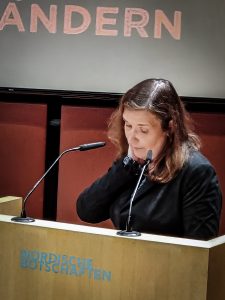
Ambassador María Erla Marelsdóttir provides a short overview of the meaning of metal in the Nordic countries in her opening note. The idea was born when some years ago, figures were published marking the Nordic countries as those with the highest number of metal bands per capita. The focus of the exhibition on metal from the Nordic countries by default moves the spotlight on extreme metal subgenres and the time since approximately 1990. The ambassador points out that extreme in this case equals music that is not easy to digest, as she puts it. Furthermore, she happily explains the unexpected high number of visitors for the exhibition as much as the accompanying events such as today. Of course, she has to refer to the visit of the president of Iceland to Wacken in , too (check out our interview with Þrainn from Skálmöld and how he experienced Wacken and their gig being visited by the President). As Ambassador Marelsdóttir says, the perception of the exhibition had broken all records. This reflects not only the importance of metal in the current Nordic culture but also its role in the metal scene, in particular in Germany, too. Ambassador Marelsdóttir recommends the podcast to the exhibition. She closes by reading out loud one verse of a Skálmöld song in Icelandic to underline the close link of metal with the Nordic cultural heritage in general and the Icelandic in particular.
Passion and expertise in the making of the exhibition
Ika Johannesson, Swedish music journalist, author and metal enthusiast curated the exhibition, and with the invitation to do so a dream came true. Co-curators·were vocalist Silje Wergeland (The Gathering) and festival manager Torgrim Øyre (Beyond The Gates). Ika tells us in her opening talk that unlike the embassy side of the organizers, she was not at all surprised by the success of the event. More than 20.000 people visited the exhibition.
Ika gives some short insights to her own biography. She grew up in the tape trading circles of the Gothenburg metal scene. Some of her teenage friends by now have become veterans of what we name the Gothenburg Death Metal genre.
She compares the intensive emotions and massive energy of metal with what opera fans come to experience for example in Bayreuth at the Wagner Festspiele annually. That might be a wild image for the mainstream lovers of soft pop or banal schlager, yet I think, we on the metal side of things get her image and agree.
The catalogue of the exhibition is a masterpiece of its own. It catapults you back into the early 1990s, when Nordic metal woke to conquer the world by trading mixed and demo tapes. The hub of the new and rapidly growing networks were the tape traders who fairly often run their own fanzines which would come with the traded tapes. (Click on a photo to open the gallery mode.)
“Those who know know, you know (Ika Johannesson)
About the exhibition, Ika tells us it comprises of devotionals from bands from the 1990s up to today and mainly on the extremer genres with a special emphasis on Death and Black metal. The owner of The True Mayhem Collection, Black Metal expert Finn Håkon Rødland supported the exhibition with a vast range of items. One of Ika’s personal highlights is for example an original back stage pass of the Mayhem concert at Eiskeller in Leipzig in December 1990. “Those who know, know, you know”, she says about it with wide smile. For those who don’t: The video footage from that show went viral and granted Mayhem world-wide popularity in a whiff. Why? Maybe give this interview with the promoter of that Mayhem tour through Eastern Germany in autumn 1990 a read (here).
“I Close My Eyes So I Can See” (Sylvaine)
Metal is more than music and as numerous bands on their recent tours underlined, metal does not depend on distorted guitars on stage. A humble young woman in a long black dress with shining fair, very long hair enters the small stage, and picks up her semi acoustic guitar to play a four-songs set with few technical support.
– Fortapt
– I Close My Eyes So I Can See
– Mørklagt
– Eg Er Framand (traditional Norwegian folk song)
Sylvaine’s voice is magic and her guitar play passionate. Most of the time atmospheric clean vocals linger in the air. The link to Nordic legends is undeniable. Then, just when you are to lose yourself in the siren’s seduction, harsh screams wake as hard soft as the rolling thunder.
You have the rare opportunity to experience such a kind of naked performance, stripped from distortions. With only very basic support from any kind of gadget, the quality of the performer hits in your face. For better or worse and this case for astonishing greatness. It makes all the difference to experience the switch from clean to harsh vocals and back within the blink of eye. There is nothing but a semi acoustic guitar playing along. The demanding song writing is just as obvious. In times of gigs overloaded with backing tracks, click track and an endless range of distorters to choose from, the actual skill of the performers becomes a well-hidden needle in a huge pile of hay. Not here and now. Sylvaine even puts more fudge on the cake by singing the final track “Eg Er Framand” solo. No guitar. Only her voice. Brilliantly delivered, and man, this takes guts!
The future of metal
During the short change-over break, some words from the previous talks echo in my mind. Provocation was essential in metal, they said. Well, provocation seems to have become an acceptable feature of public verbal as well as non-verbal communication nowadays, not only in politics. It is omnipresent in street fashion, self-staging of the rising machismo, or reflects in gestures and body language, to name only few. Has this laid the grounds for metal rise towards acceptation by the mainstream? From a different view on our society, the significantly growing social polarisation is visible and undeniable. The middle is declining as the margins flourish. Do those new marginal end up in metal?
Hoping the panel will address my thoughts, the moderator introduces the panel, however, misses to introduce himself.
Ivar Bjørnson/Enslaved
Ika Johannesson/Curator of “Der harte Norden”
Torgrim Øyre/Beyond The Gates (founder and principal organizer)
Finn Håkon Rødland/The True Mayhem Collection
Kathrine Shepard/Sylvaine
Being allowed to celebrate achievements
“Death is alive”, Ivar whispers as Håkon excuses “we’re getting old”, and as Torgrim puts it: celebrating achievements of the past should be allowed. In the line-ups of the Beyond The Gates festival in Bergen/Norway, Torgrim would always combine the both ends: new bands and old ones. The latter would sell the tickets. Nevertheless, the hope to find some gems among the new would pull the people to the stage. He would not hire holographic performers, replies being explicitly asked for it.
“Metal is a pretty conservative genre”, Ika says, explaining that consequently it is hard for new bands to establish innovations. It seems to be easier to make it by copying from the old in one way or another.
Metal is not about being popular
Kathrine emphasises that she does not believe in labelling boxes and that metal has implemented features of its neighbours, such as folk or techno. She has never labelled her own music as metal.
Ivar – often accused of pushing the boundaries metal too far, describes metal as a spiritual thing, something we like. His kids are in ballet dancing and a circus school. They still could not be more metal because either is social, integrative and about skill. Neither is not about being popular or sexy like metal. He adds with a blink at least not in Black Metal in Norway in the 1990s. “How much did you involve yourself in the scene to get accepted” back in the day tipped the scale. Ika agrees and adds that it is about reference and recognition. Thus pushing boundaries will get you hate in the community.
Pushing the boundaries and recognition are keywords for Håkon’s example, the latest Satyricon album “Satyricon & Munch” which is very polarising. To him, however, the album conveys a feeling making it true Black Metal; even more than most [supposedly of Satyricon’s music] in the past 20 years. “Sexy album”, Ivar drops.
What will come after Iron Maiden retire – a band somehow everybody can agree on?
Torgrim explains that there can never be another Metallica, Black Sabbath or the like as the myth building takes time. Nowadays people pay too much attention on the colour of the toilet paper a band uses. While Ika points out that the spectrum to choose from has grown too big. Ivar agrees with the role of time. He also explains the obstacle of making a living from the royalties. Ivar bought his first car in 1994 from the royalties of their album while nowadays he may pay new wipers but nothing more. The underlying development sped up with the piracy period in the 2000s. For him it is important to that he is not complaining about some kids getting music for free but about the sharks who made a fortune in the background from it.
Current version tape trading and collecting vinyls
Funny enough, streaming music has become normal and contextually preferred even by the panel members. Swapping playlists replaced swapping or trading tapes, Ika says. Interestingly, she complains her old tapes would not work anymore. Yet Ivar has a cassette player in his car and does use it still. At that point, the freak-mode kicks in as Håkon begins explaining how different cassette brands have their unique soundscapes. The natural next step is diving in vinyl nostalgia, of course. The discussion moves on the question for how long there will physical formats at all. To Håkon, this is vitally related to “our generation” in which collecting physical devotionals has an emotional value. That however, will die with the generation. Tapes were so insignificant, Ivar says. Even when back in the day, someone broke into Euronymous’ car. That one stole literally everything; the tapes of the forthcoming Mayhem album were left behind.
The future of metal: Cross events?
Undeniably, metal has moved closer to the mainstream. Cross events such as Entombed at the opera with a ballet dancing in 2002, mark a turning point to Ika. Although the memorability of the event when Hells Angels were sitting next to perfectly dressed opera lovers might go beyond the performance on stage. The number of metal acts invited to and awarded at national music award ceremonies has been growing remarkably since Dimmu Borgir in Norway in 1998, as Torgrim mentions. Håkon continues the thought. He is sure Black Metal has become an important chapter of the national heritage in Norway whereas perhaps million seller mainstream acts or major developments might turn out to become no more than a short mentioning.
Metal is taken more serious by sophisticated genres supposes the moderator to which Ika replies that metal muscians in their mid fourties are all but rebellious.
The discussion of which bands will make the big headliners in ten years from now ends in suggestions of all will unless they are older than 80 years by. That again is in Kathrine’s view is merely the question. To her it is clear that all these bands “will literally die on stage” but the critical point: who can replace those once they will have gone?
You can’t change a picture from inside the frame. (Ivar Bjørnson)
With that the audience is invited to come with some questions. This is my opportunity and the questions I had in the beginning. “You spoke a lot of metal is becoming more acknowledged by the mainstream. You gave plenty of examples. But why is this so?”
Torgrim sees the main reason reflected in his own biography and nepotism. “We’re sitting in high positions. ” So there is the power to influence and important people to speak of metal and their history with metal. In Ika’s perceptions, we have never really become adults in the way previous generations did. We would still go to concerts and festivals. To Håkon the ones who made it in the early 1990s had to prove double and delivered. The quality of music produced then is the cream that simply rose to the top. Naturally, they all agree on the important role of the quality of metal music in this question.
The metal haven offers deep and dark feelings
To Kathrine, the entire metal genre is rather young, approximately 60 years. It has taken its time to become classic. Beyond those internal factors, however, the world has found a place and need of music that expresses deeper and darker feelings. Later in a short conversation meeting her in the exhibition, she agrees on the integrative force of the metal community and its role for the growing number people feeling marginal.
Ivar points into yet another direction. He reminds us of the hostile environment especially the Black Metal fans found themselves in the beginning. To him it was a cultural war. Metalheads got beaten up, automatically taken as foes and so on. The roots of these prejudices, the reason “the actual war”, Ivar sees mainly in religion that to him “has to be removed from public space. You can’t change a picture from inside the frame.” Black Metal fought this war.
What remains?
As the exhibition closed, there is no sense in spoiling you with more details of it than I can show in some photos. What remains, however, is a very cool exhibition catalogue. Furthermore, there is of course a number of books, such as Ika Johannesson’s “Blood, Fire Death – The Swedish Metal Story” and Markus Laako’s “Amorphis Biography”. Both were part of the exhibition, too, of course.
Images by Muumi-Katja

